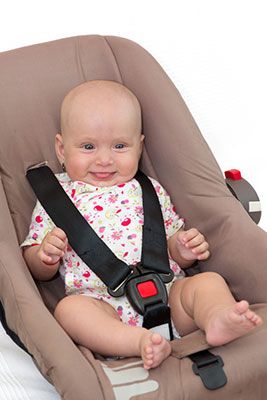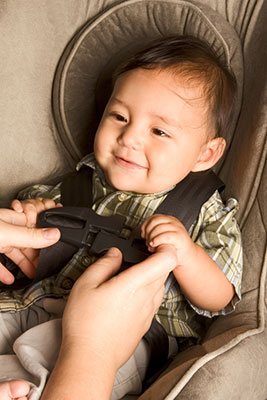As a mom, making sure your little one is safe and secure when you're on the go is essential. One of the car seat options that has grown in popularity over recent years is the rethread harness car seat.
If you're considering getting one for your child but are unsure if it's suitable for them or how best to use it, this blog post will provide all the answers!
We'll look at what makes these seats unique, their pros and cons, plus tips on proper installation. So if you're looking for an informed answer to "Is a rethread harness good for my little one?" - read on!
More...
Take Away Key Points:
Table of Contents
- Should you use a rethread harness on car seats?
- Safety tips for secure installation of rethread harness
- How to install a no-rethread harness in a car seat?
- Rethread vs. No-rethread harness: What is better for growing children?
- European belt path vs. American belt path: The difference
- Do booster seats use the (no)rethread harness?
- Do booster kids need rethread or no-rethread harness?
- FAQs
- Conclusion
Should you use a rethread harness on car seats?
Car seat safety standards require your children to be properly buckled in the five-point harness system when in a rear-facing or forward-facing car seat.
However, what is the difference between the non-rethread and rethread harness, and how do they work? Read below.
1. What is a rethread harness?

A rethread harness is an adjustable harness found in car seats that allows you to raise and lower the harness straps. First, however, you must unhook and reroute them.
This type of adjuster is not helpful for infant car seats, as you must adjust the straps as your baby grows, but you must rethread them to find the best harness height for your child. It also provides a visible reminder of when the straps must be adjusted again.
2. What is a no-rethread harness on infant car seats?
A no-rethread harness is a safety device found on many infant car seats. The harness straps need not be rerouted or unhooked to find the best strap height for your little one.
No-rethread harnesses are mostly found on rear-facing car seats, as the harness straps allow you to loosen or tighten the shoulder straps to fit the child's shoulders. As your child grows, you can re-adjust the shoulder straps again and ensure they match your child's shoulders correctly.
3. Are rethread harness straps safe for car seats?
Yes, rethread harness straps are safe for car seats. However, many car seats now come with a no-rethread harness, which allows you to adjust the straps without having to unhook and reroute the harness. This adjuster generally operates by squeezing a lever or pushing a button.
All straps must lie flat even when adjusting the rethread harness. If the strap twists while parents are re-threading the harness, undo the harness and re-thread it properly.
You will find multiple harness slots. To properly position the shoulder straps in the rear-facing infant car seat, ensure the shoulder strap lies at or below the child's shoulders. For the forward-facing car seat, ensure the shoulder strap is at or above the child's shoulders.
Safety tips for secure installation of rethread harness

Secure installation of a rethread harness is an important safety measure for any car seat. Here are some tips to ensure your child's safety:
- Make sure the harness straps are snug and not too loose.
- Ensure that the chest clip is at armpit level and securely fastened.
- Adjust the straps as your child grows, ensuring they fit snugly around their body.
- Check that the car seat is correctly installed in the vehicle, either with a seat belt or lower anchor connectors.
- Read the car seat manual carefully and follow all instructions for proper installation and use of the harness straps and other car seat components.
- When adjusting your car seat's rethread harness, always remove slack at your child's hips by pushing down the crotch buckle and pulling up on the straps in their torso area.
How to install a no-rethread harness in a car seat?
When your child is in a rear-facing position in the infant car seat, you need to install the non-rethread harness straps.
Remember, the non-rethread harness doesn't have multiple harness slots like rethread models; it has only one slot. So to install the harness, you should:
- Thread the straps through the appropriate slot according to your car seat manual's instructions.
- Make sure all of the straps are routed correctly, with shoulder harnesses and chest clips at their correct harness height and even tension throughout.
- Connect the lower anchors or vehicle belts to your car's anchor points and adjust the tension until you feel the car seat is secure in place.
- Ensure that all the harness straps lie flat against your child's body and that there is no twist in them. Twisted straps will not provide the safety features for your little ones in crash forces.
- Check the instruction of the car seat manufacturer to find the correct angle for the rear-facing infant seat
- Ensure you adjust the anti-rebound bar for the best security in the car
Whatever type you use, you must ensure the tether anchor is in the center position for the five-point harness to provide maximum safety for the forward-facing or infant seats.
Rethread vs. No-rethread harness: What is better for growing children?
When choosing the correct car seat harness for growing children, there are two main options: rethread and no-rethread.
Rethread harnesses require you to unhook and reroute the straps each time you need to adjust them, while no-rethread harnesses allow you to adjust the straps without having to do so.
No-rethread harnesses are generally more convenient than rethread ones, as they allow quick adjustments without taking apart the entire seat. This is especially helpful when your child overgrows and needs frequent adjustments.
The no-rethread harness is generally easier to use, as they often operate by squeezing a lever or pushing a button. Finally, when your kids grow, you can re-adjust the straps with the adjustable headrest.
On the other hand, rethread harnesses provide a more secure fit since they require you to route the straps through specific slots to adjust them. This ensures that the straps are always adequately positioned on your child's body for maximum safety and comfort.
Ultimately, both car seat harnesses can be effective for growing children depending on your needs and preferences. For example, if convenience is your top priority, then a no-rethread harness may be best for you; however, if security is more important, a rethread one may be better suited for your needs.
European belt path vs. American belt path: The difference
Belt paths decide how you will install a car seat without a base. The main difference is that the European belt path wraps the belt around the back of the infant car seat for extra protection, decreasing pressure and external forces and adding stable installation.
The American belt path also routes the vehicle's lap belt over the baby's lap area, but it might not provide as stable connectors as the EU belt path.
Do booster seats use the (no)rethread harness?

A booster seat uses the vehicle seat belt system, so they do not use the rethread or no-rethread harness. However, a convertible car seat (3-in-1 or 4-in-1 models) can come with the harness straps, as these are all-in-one, and you get three car seats or even four in one convertible seat.
But, generally, the booster car seat will use the vehicle seat belt - shoulder and lap belt portion instead of the LATCH system for car seat installation.
To use these seats in the back seat of your vehicle, you must ensure the correct fit of your child and the car seat. For example, the shoulder belt must cover the child's shoulders and chest, while the lap belt must cover the upper thighs and hips.
Do booster kids need rethread or no-rethread harness?
If the belts fit your kids correctly, they can use their booster freely. If, however, the vehicle's seat belt cannot cover the booster children, it is a big deal, and you must reverse your child back to rethread or no-rethread harness straps in the forward-facing seat. This way, you will add more safety and prevent slouching or slipping away in the back seat of your vehicle.
Many parents rush with seat belts, so pay attention to the safety, height, and weight limits to ensure they use the best forward-facing/booster car seat.
FAQs
How to rethread car seat straps?
Follow the steps below: Detach the straps from the adjuster strap, thread the straps through the correct harness slots. Reattach the straps to the adjuster strap. Make sure and consult your manual for directions specific to your car seat.
Which infant car seats have a no-rethread harness?
Some of the most popular no-rethread car seats include:
- Chicco KeyFit 35 Infant Car Seat and Base
How to rethread the harness on the Graco car seat?
To rethread the harness on the Graco car seat, follow the steps below:
- You need to loosen the harness straps by lifting the lever and pulling the shoulder straps out
- Remove both shoulder harness strap loops from the splitter plate on the back of the child restraint
- Depending on your model, you may have a rethread or no-rethread harness
- With a rethread harness, you can simply detach the harness straps from their current slots and move them to different slots without having to uninstall your car seat
- If you have a no-rethread harness, you must uninstall your car seat to adjust the harness.
Conclusion
As you have seen, both harness types are ideal for rear-facing or forward-facing infant seats. The only difference is that you need to thread the straps through multiple slots in a regular harness, while you can only adjust them in the non-rethread harness.
But, many claim the regular option is safer as you will manually find the best tightness and security for your child, and many opt for this option. So, you can decide based on all facts listed above.
